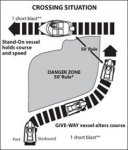Re: Coast guard hits a boat....
Hopefully this is not a repost...Coast guard hits a runabout, coast guard at fault?!
http://www.break.com/usercontent/2008/4/Coast-Guard-Hits-And-Sinks-Boat-483877.html
In watched and listening to the video above and it sounds like the person who is doing the talking is on board " The Coast Guard Auxiliary Boat " and he says the boat is being run buy what he called a (
" Civilian Volunteer " )
This is the same boat ( " The Coast Guard Auxiliary Boat " ) which hit the smaller craft in the video.
He says that they ( " The Coast Guard Auxiliary Boat " ) are the ones who are are blocking other pleasure craft from entering the area under investigation while the ( Coast Guard Boat ) searches the scene looking for the man in the water.
Both boaters ( Of the large and small vessels ) were at fault by Law.
The person running ( " The Coast Guard Auxiliary Boat " ) broke the rules of crossing by not yield right of way to avoid the accident, and did not sound his horn which is also required by law.
Crossing Rule = with picture at bottom:
When two power-driven vessels are crossing so as to involve risk of collision,
the vessel which has the other on her starboard side shall keep out of the way and shall, if the circumstances of the case admit,
avoid crossing ahead (in front) of the other vessel.
When taking action to stay out of the way,
make it early, substantial and well clear of the other boat. Avoid making a succession of small alterations of course or speed.
If you are directed by the Rules to stay out of the way, then make your turn large and obvious so as to be readily apparent to another vessel both visually or by radar. This is especially true at night, when the only visual indication of your course change is the alteration of your boat's lights.
The Smaller boat did have the right of way, and comes under the
Give-way and Stand-on Vessels rules of the water way.
Even thought this boater ( The Small Boat ) was not paying attention, and did not sound his horn either as the law also requires, he did have the right of way.
The ( " Civilian Volunteer = Piloting The Coast Guard Auxiliary Boat " ) was mainly at fault by not obeying the rules of the water ways ( yielding the right of way ) which he should be well knowledgeable of.
There is also a 50 ft. rule to take into consideration which was not obeyed.
Civilian Volunteers ... don't have that much training.
Give-way and Stand-on Vessels:
"Give-way"
means every vessel directed to keep out of the way of another vessel must, so far as possible,
take early and substantial action to keep well clear.
"Stand-on" means when one of two vessels is to keep out of the way, the other (stand-on)
shall keep course and speed, except however, the stand-on vessel may take action to avoid collision by maneuvering alone, as soon as it becomes apparent that the
vessel required to keep out of the way is not taking appropriate action as required and may take such action as will best aid to avoid collision.
If the stand-on vessel must take action to avoid a collision,
it must avoid turning to port for a vessel on her port side.
An action taken to avoid a collision needs to be positive, made in ample time and large enough to be apparent to the other vessel. A succession of small alterations of course or speed is to be avoided.
If necessary to avoid a collision or allow more time to assess the situation, a vessel must slacken her speed or take all way off by stopping or reversing engines.
If there is any doubt as to whether or not a risk of collision exists, always default to the risk existing. In determining if risk of collision exists, take the following considerations into account; such a risk exists if the compass bearing of an approaching vessel does not appreciably change and that such risk may sometimes exist even when the appreciable bearing change is evident, particularly when approaching a very large vessel or a tow or when approaching a vessel at close range.
Power boats must "stay out of the way" of
a sailing vessel regardless of the angle the power-driven vessel approaches the sailing vessel.
Departure From Regulations to Avoid Immediate Danger:
In obeying and construing the navigation rules, due regard shall be had to all dangers of navigating and collision and to any special circumstances which may render a departure from these rules necessary in order to avoid immediate danger. When, from any cause the vessel required to keep its course and speed finds itself so close that collision cannot be avoided by the action of the give-way vessel alone, the operator shall take such action as will best aid to avoid collision.
This action does not relieve the give-way vessel of its obligation to keep out of the way. The give-way vessel is that vessel required to take early and substantial action to keep well away from other vessels by stopping, slowing or changing course.
Exoneration:
No operator is exonerated from the consequences of any neglect to carry and display navigation lights as required by law;
or of any neglect to keep a proper lookout, or of the neglect of any reasonable precaution which may be required by the ordinary practice of good seamanship or by the special circumstances of the case.
A full copy of the Navigation Rules (PDF), published by the US Coast Guard, is available at the USCG's Web site (PDF) or by contacting the Government Printing Office.
CROSSING EXAMPLE:
Click on pic. to make larger.
.




















